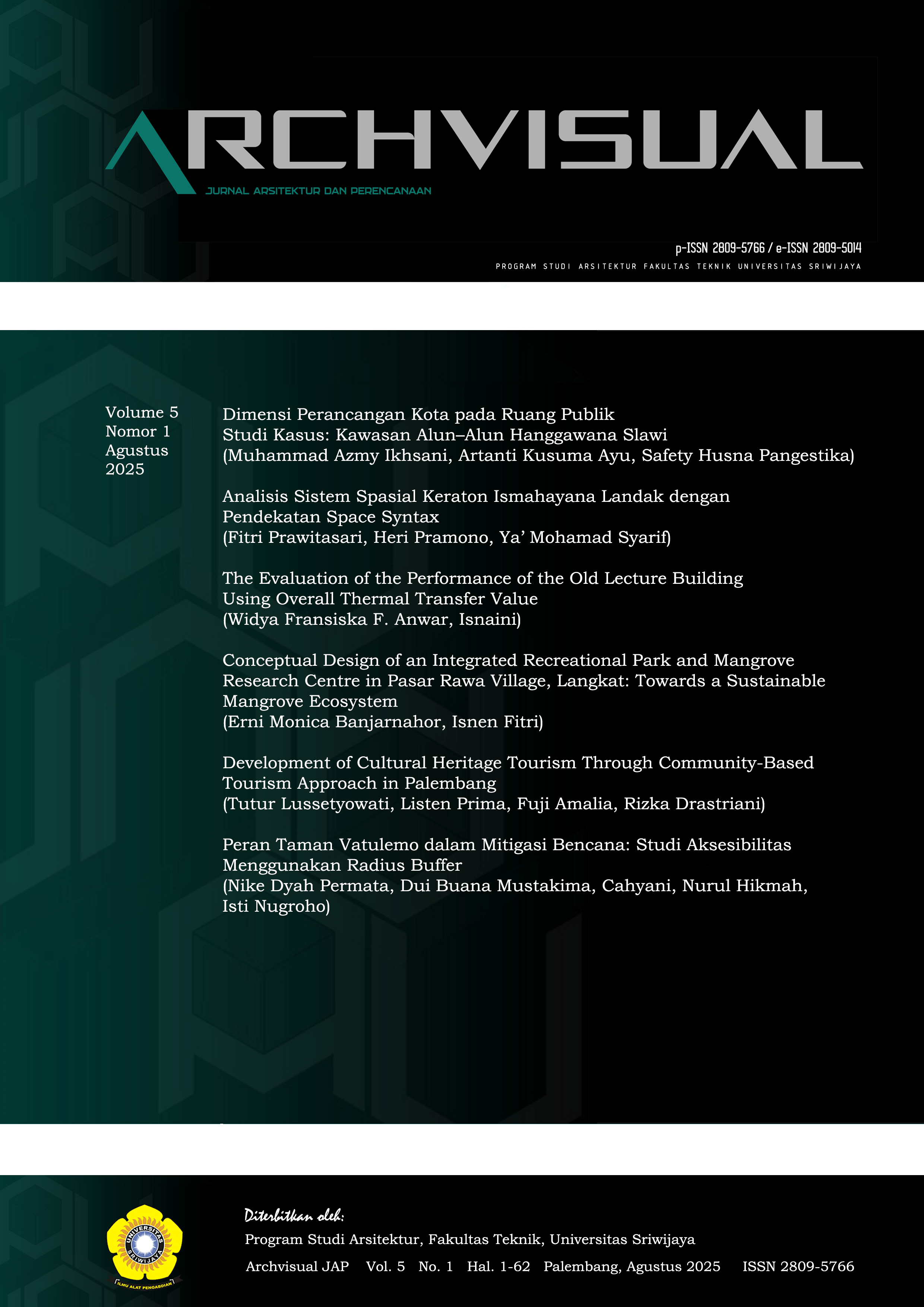The Evaluation of the Performance of the Old Lecture Building Using Overall Thermal Transfer Value
Main Article Content
Abstract
The old lecture building is one of the campus assets that is still used for lectures. Generally, buildings like this are built with different climate conditions than today. The lecture process requires conducive and comfortable conditions for students and teachers. It is necessary to conduct an evaluation of building performance to assess the building's ability to create comfort for its users. The problem in this study is how the performance of a lecture building that was built more than 50 years ago, whether it can still provide the same comfort as when this building was newly built. This study aims to determine whether the old lecture building is able to create comfort that is in accordance with current lecture activities. To achieve this goal, this study measures the performance of the Lecture Building “I” using the Overall Thermal Transfer Value (OTTV) parameter. This study method is quantitative in the form of calculating the building envelope of Lecture Building “I”, which is the old lecture building of the Faculty of Engineering, Sriwijaya University. The results show that the OTTV value of building I is 38.22 watts/m2. This study concludes that the Lecture Building ”I” has not been able to create comfort for its users. The effect of this is the waste of electrical energy used in air conditioning. The study suggests replacing the opening material with one that reduces heat transmittance to the interior of the building.
Article Details
Section

This work is licensed under a Creative Commons Attribution-NonCommercial 4.0 International License.
How to Cite
References
Akram, M. W., Mohd Zublie, M. F., Hasanuzzaman, M., & Rahim, N. A. (2022). Global Prospects, Advanced Technologies and Policies of Energy-Saving and Sustainable Building Systems: A Review. Sustainability, 14(3), 1316. https://doi.org/10.3390/su14031316
A’yun, Q. (2023) Identifikasi Pengaruh Bentuk Desain Bangunan terhadap Intensitas Konsumsi Energi Melalui Metode Simulasi Komputasional Sefaira, Nature, Vol.10.(10). hlm 130-143.
https://doi.org/10.24252/nature.v10i2a2
Broadway, L.A., et.al. (2025). Building age is a determining factor of indoor CO2 levels in a university setting. Indoor Environments, 2 (2),100100, https://doi.org/10.1016/j.indenv.2025.100100
Chou, S.K., Chang, W.L. (1996). A Generalized Methodology for Determining the Total Heat Gain Through Building Envelopes. International Journal of Energy Research. Vol.20 (10) hlm. 887-901.
https://doi.org/10.1002/(SICI)1099-114X(199610)20:10<887::AID-ER202>3.0.CO;2-T
Efiariza, R. R., Hikmah, N., Damanik, N. H. C., & Ayutia, G. T. (2025). Studi Nilai Transfer Panas Keseluruhan Pada Selubung Bangunan Pusat Kegiatan Mahasiswa. Jurnal Ilmiah Poli Rekayasa, 20(2), 60-66.
http://dx.doi.org/10.30630/jipr.20.2.395
El-Darwish,I and Gomaa,M. (2017). Retrofitting Strategy for Building Envelopes to Achieve Energy Efficiency, Alexandria Engineering Journal, 56 (4). 579-589
https://doi.org/10.1016/j.aej.2017.05.011
Gigante, A. et.al. (2024). Indoor quality-oriented approach for the performance evaluation of building retrofit with façade transformation: Case study of student dormitory in Mediterranean climate. Energy and Buildings. 312, 114227
https://doi.org/10.1016/j.enbuild.2024.114227
Harmati, N.L., Folic, R.J., Magyar, Z., Drazic, J.J., Kurtovic-Folic, N. (2016). Building Envelope Influence on The Annual Energy Performance in Office Buildings. Thermal Science. Vol.20 (2) hlm 679-693.
https://doi.org/10.2298/TSCI141111109H
Hidayat, MS. (2022) Studi Overall Thermal Transfer Value (OTTV) di Gedung Kampus Universitas.Metrik Serial Teknologi dan Sains. Vol.3(2). hlm 1-7. https://doi.org/10.51616/teksi.v3i2.344
Hidayat, M. S., & Bachri, A. (2025). Studi Window-to-Wall Ratio dan Pengaruhnya terhadap Temperatur Udara dalam Ruang Kelas untuk Mencapai Bangunan Hemat Energi. Jurnal Lingkungan Binaan Indonesia, 14(2), 108-115. https://doi.org/10.32315/jlbi.v14i2.475
Mas' um, I. N., Amalia, R. R., & Musda, G. H. (2024). Analisis OTTV (Overall Thermal Transfer Value) sebagai Pendekatan Arsitektur Hemat Energi pada Selubung Bangunan Museum Kota Makassar. Jurnal Ilmu Pengetahuan Dan Teknologi (Iptek), 8(2), 7-11. https://doi.org/10.31543/jii.v8i2.341
Octafiansyah, H. A., Marwati, A., & Wasnadi, H. F. (2024). Analisis Fasad Bangunan Itb Ahmad Dahlan Karawaci Dengan Perhitungan Overall Thermal Transfer Value (OTTV). RUSTIC: Jurnal Arsitektur, 4(1), 49-71.
https://doi.org/10.32546/rustic.v4i1.2360
Octarino, C. N., & Feriadi, H. (2021). Evaluasi Kinerja Selubung Bangunan Gedung Agape Universitas Kristen Duta Wacana Yogyakarta. Langkau Betang: Jurnal Arsitektur, 8(2), 86-97. https://doi.org/10.26418/lantang.v8i2.45436
Wibowo, T., Yudiarma, Y., & Fitriyanto, A. (2024). Analisis Nilai Termal Selubung Bangunan (OTTV) Pada Bangunan Gedung Direktorat Politeknik Negeri Pontianak sebagai Indikator Penilaian Kinerja Bangunan Gedung Hijau menggunakan Building Compliance Form V3. 0. Vokasi: Jurnal Publikasi Ilmiah, 19(1), 34-54. https://ejurnal.polnep.ac.id/index.php/vokasi/article/view/783/516
Widyakusuma, A., & Zainoeddin, A. (2022). Redesign Optimization of Campus Building Envelope With a Green Architecture Approach (Case Study: Borobudur University Jakarta). TRAVE, 26(1), 20-27. Retrieved from https://ejournal.istn.ac.id/index.php/TRAVE/article/view/1195

